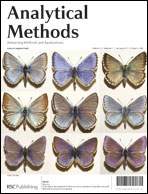Scope and limitations of principal component analysis of high resolution LC-TOF-MS data: the analysis of the chlorogenic acid fraction in green coffee beans as a case study†
Abstract
Within this contribution we have analysed aqueous methanolic extracts by


 Please wait while we load your content...
Please wait while we load your content...